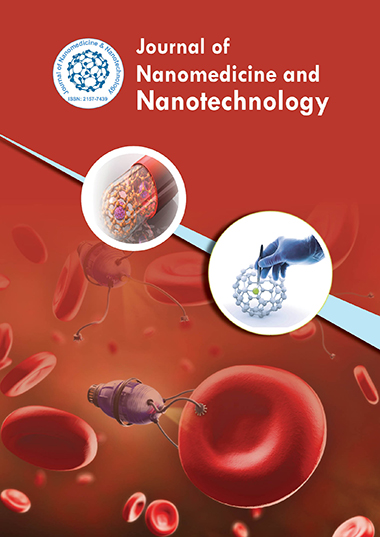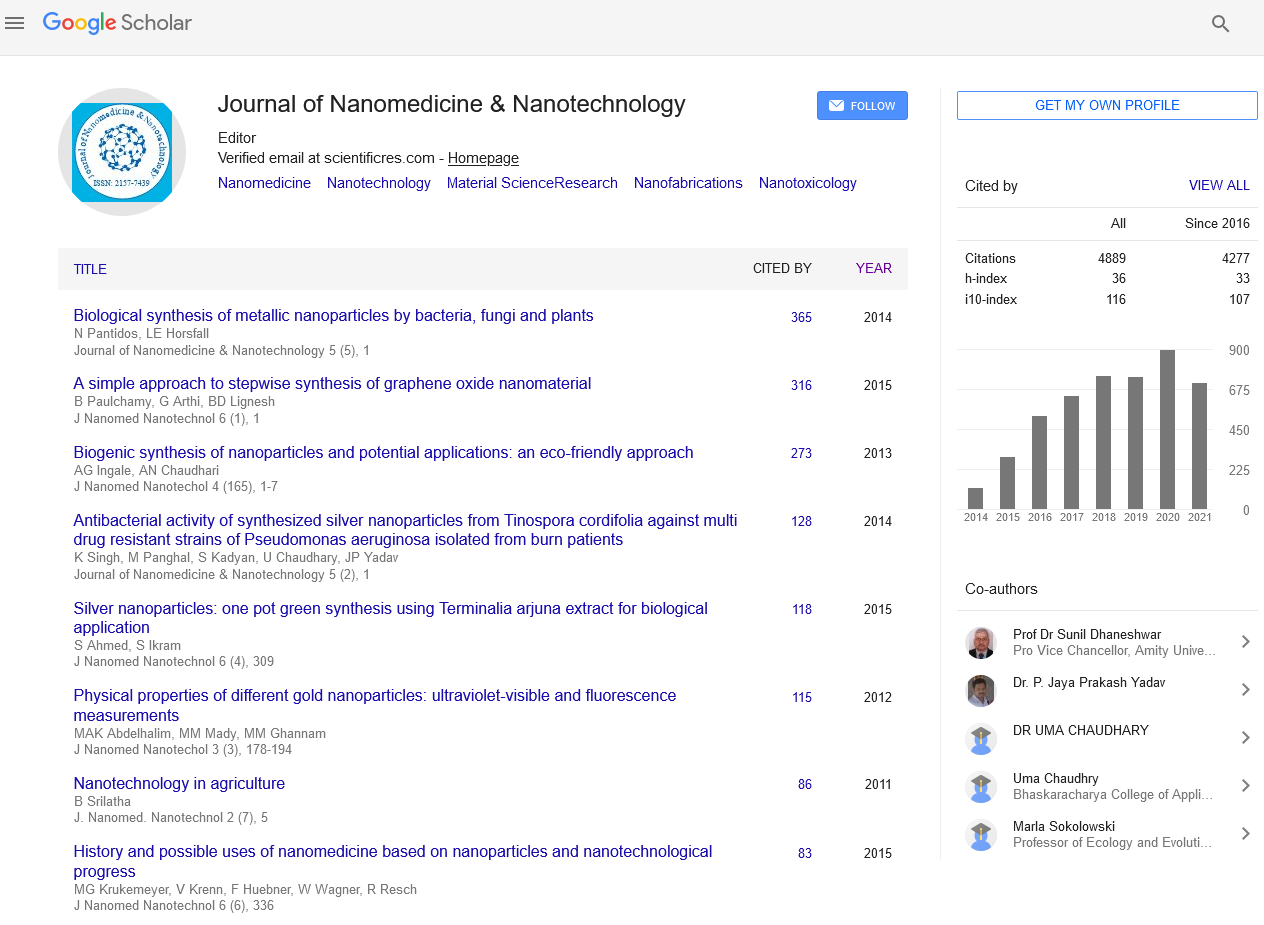Indexed In
- Open J Gate
- Genamics JournalSeek
- Academic Keys
- JournalTOCs
- ResearchBible
- China National Knowledge Infrastructure (CNKI)
- Scimago
- Ulrich's Periodicals Directory
- Electronic Journals Library
- RefSeek
- Hamdard University
- EBSCO A-Z
- OCLC- WorldCat
- SWB online catalog
- Virtual Library of Biology (vifabio)
- Publons
- MIAR
- Scientific Indexing Services (SIS)
- Euro Pub
- Google Scholar
Useful Links
Share This Page
Journal Flyer

Open Access Journals
- Agri and Aquaculture
- Biochemistry
- Bioinformatics & Systems Biology
- Business & Management
- Chemistry
- Clinical Sciences
- Engineering
- Food & Nutrition
- General Science
- Genetics & Molecular Biology
- Immunology & Microbiology
- Medical Sciences
- Neuroscience & Psychology
- Nursing & Health Care
- Pharmaceutical Sciences
Editorial - (2024) Volume 15, Issue 5
Nanotechnology in Vaccine Development Innovations and Implications
Saoirse McAllister*Received: 03-Sep-2024, Manuscript No. jnmnt-24-27233; Editor assigned: 05-Sep-2024, Pre QC No. jnmnt-24-27233 (PQ); Reviewed: 20-Sep-2024, QC No. jnmnt-24-27233; Revised: 24-Dec-2024, Manuscript No. jnmnt-24-27233 (R); Published: 30-Sep-2024, DOI: 10.35248/2157-7439.24.15.756
Abstract
Nanotechnology has revolutionized vaccine development, offering innovative strategies to enhance vaccine efficacy, safety, and delivery. This article reviews recent advancements in nanotechnology applications for vaccine development, focusing on nanoparticle-based vaccines, adjuvants, and delivery systems. The article also discusses the challenges and future prospects of integrating nanotechnology into vaccine design, emphasizing its potential to address emerging infectious diseases and improve public health outcomes.
Keywords
Nanotechnology; Vaccine Development; Nanoparticles; Adjuvants; Delivery Systems; Infectious Diseases
INTRODUCTION
Vaccination is one of the most effective public health interventions for preventing infectious diseases. However, traditional vaccine development often faces challenges related to efficacy, stability, and the need for boosters. Nanotechnology, the manipulation of matter at the nanoscale (1-100 nm), offers novel approaches to enhance vaccine performance. By utilizing nanoparticles and other nanomaterials, researchers can improve antigen presentation, stimulate stronger immune responses, and enable targeted delivery [1].
NANOPARTICLE-BASED VACCINES
Types of Nanoparticles
Nanoparticles can be broadly categorized into several types based on their composition and structure, including:
Lipid-based nanoparticles: Liposomes and solid lipid nanoparticles (SLNs) encapsulate antigens, enhancing their stability and bioavailability.
Polymeric nanoparticles: Biodegradable polymers, such as PLGA (poly(lactic-co-glycolic acid)), can deliver antigens in a controlled manner, providing sustained release and improving immunogenicity [2].
Inorganic nanoparticles: Gold, silica, and iron oxide nanoparticles can serve as carriers for antigens and adjuvants, enhancing vaccine efficacy through their unique physicochemical properties.
MECHANISM OF ACTION
Nanoparticle-based vaccines can enhance the immune response through several mechanisms:
Improved antigen presentation: Nanoparticles can mimic pathogens, facilitating uptake by antigen-presenting cells (APCs) such as dendritic cells. This leads to increased processing and presentation of antigens to T cells.
Targeted delivery: Functionalization of nanoparticles with ligands or antibodies enables targeted delivery to specific cells, improving the precision of immune activation [3].
Sustained release: Nanoparticles can provide a controlled release of antigens, prolonging exposure and stimulating a stronger immune response.
Nanoparticle Adjuvants
Adjuvants are substances that enhance the body’s immune response to vaccines. Nanotechnology allows for the development of novel adjuvants that improve vaccine efficacy.
MECHANISMS OF ADJUVANTICITY
Nanoparticle-based adjuvants enhance immune responses through various mechanisms
Activation of immune pathways: Nanoparticles can stimulate pattern recognition receptors (PRRs) such as Toll-like receptors (TLRs), leading to the activation of innate immune responses [4].
Delivery of multiple signals: Nanoparticles can co-deliver antigens and immunostimulatory molecules, promoting robust T and B cell responses.
Examples of Nanoparticle Adjuvants
Chitosan nanoparticles: These biodegradable nanoparticles enhance the mucosal immune response and have been used in oral vaccines.
Calcium phosphate nanoparticles: These nanoparticles can efficiently deliver both antigens and TLR agonists, significantly enhancing immune responses in preclinical models [5].
DELIVERY SYSTEMS
Needle-Free Vaccination
Nanotechnology can facilitate needle-free vaccination, which is particularly beneficial in improving vaccine acceptance and compliance.
Microneedles: These are tiny needles that can deliver vaccines through the skin with minimal pain. Microneedles coated with nanoparticles can enhance antigen delivery and uptake by APCs.
Sprayable formulations: Nanoparticle-based formulations can be developed for intranasal or oral delivery, providing alternative routes of administration that can elicit strong immune responses [6].
Controlled Release Systems
Nanoparticles can be engineered for controlled release of antigens, allowing for sustained immune stimulation.
Hydrogel-based systems: These systems can encapsulate antigens and release them in a controlled manner, prolonging exposure and enhancing immune responses.
pH-sensitive nanoparticles: These nanoparticles can release their cargo in response to specific pH changes, such as those found in the inflamed tissues of the body, enhancing targeted delivery [7].
CHALLENGES IN NANOTECHNOLOGY-BASED VACCINE DEVELOPMENT
While nanotechnology offers significant advantages in vaccine development, several challenges remain:
Safety and Biocompatibility
Ensuring the safety and biocompatibility of nanomaterials is crucial. The potential for toxicity and unintended immune responses must be thoroughly evaluated through preclinical and clinical studies.
Manufacturing and Scalability
The production of nanoparticle-based vaccines must be scalable and reproducible. Standardization of manufacturing processes is essential to ensure consistency in vaccine quality [8].
Regulatory Considerations
The regulatory pathway for nanotechnology-based vaccines is still evolving. Clear guidelines are needed to assess the safety and efficacy of these innovative products.
CASE STUDIES SUCCESSFUL APPLICATIONS
mRNA Vaccines
The rapid development of mRNA vaccines for COVID-19, such as the Pfizer-BioNTech and Moderna vaccines, showcases the potential of nanotechnology. Lipid nanoparticles encapsulate mRNA, facilitating its delivery into cells and enhancing the immune response.
Cancer Vaccines
Nanoparticle-based cancer vaccines are being developed to elicit strong immune responses against tumor-associated antigens. For instance, lipid nanoparticles containing mRNA encoding tumor antigens have shown promise in preclinical and clinical trials [9].
FUTURE PERSPECTIVES
The integration of nanotechnology into vaccine development holds immense potential for future public health advancements. Key areas for future research include:
Personalized Vaccines
Nanotechnology can facilitate the development of personalized vaccines tailored to individual immune profiles, improving efficacy in diverse populations.
Combination Therapies
Combining nanoparticle-based vaccines with other therapeutic modalities, such as immune checkpoint inhibitors, may enhance treatment outcomes in cancer and infectious diseases.
Global Health Applications
Nanotechnology can play a crucial role in developing vaccines for neglected tropical diseases and emerging infections, especially in low-resource settings where traditional vaccine delivery systems may be inadequate [10].
CONCLUSION
Nanotechnology has the potential to transform vaccine development by enhancing the efficacy, safety, and delivery of vaccines. Through the use of nanoparticles as carriers and adjuvants, researchers are developing innovative strategies to improve immune responses and facilitate needle-free administration. While challenges remain, the successful application of nanotechnology in vaccines, particularly in the context of COVID-19, underscores its promise in addressing global health challenges. Continued research and development in this field will be essential for harnessing the full potential of nanotechnology in vaccine innovation.
REFERENCES
- Zhang N, Li X, Wang Y, Zhu B, Yang J. Fabrication of magnetically recoverable Fe3O4/CdS/g-C3N4 photocatalysts for effective degradation of ciprofloxacin under visible light. Ceramics International.2020.
- Liu S, Yu B, Wang S, Shen Y, Cong H. Preparation, surface functionalization and application of Fe3O4 magnetic nanoparticles. Adv. Colloid Interface Sci.2020; 102165.
- Mirza S, Ahmad M S, Shah A, Ateeq M. Magnetic nanoparticles: drug delivery and bioimaging applications. 2020; 189-213.
- Cho J S, Hong Y J, Kang Y C. Design and Synthesis of Bubble-Nanorod-Structured Fe2O3–Carbon Nanofibers as Advanced Anode Material for Li-Ion Batteries. ACS Nano.2015; 9: 4026.
- Asoufi H M, Al-Antary T M, Awwad A M. Magnetite (Fe3O4) Nanoparticles Synthesis and Anti Green Peach Aphid Activity (Myzuspersicae Sulzer). Journal of Computational Biology.2018; 6.
- Esmaili N, Mohammadi P, Abbaszadeh M, Sheibani H. Green synthesis of silver nanoparticles using Eucalyptus comadulensis leaves extract and its immobilization on magnetic nanocomposite (GO‐Fe3O4/PAA/Ag) as a recoverable catalyst for degradation of organic dyes in water. Applied Organometallic Chemistry.2020; 34(4): e5547.
- Sandhya J, Kalaiselvam S. Biogenic synthesis of magnetic iron oxide nanoparticles using inedible borassus flabellifer seed coat: characterization, antimicrobial, antioxidant activity and in vitro cytotoxicity analysis. Materials Research Express.2020; 7(1): 015045.
- Iravani S, Korbekandi H, Mirmohammadi S V, Zolfaghari B. Synthesis of silver nanoparticles: chemical, physical and biological methods. Int J Pharm Sci.2014; 9(6): 385.
- Sorbiun M, Shayegan Mehr E, Ramazani A, Mashhadi A. Biosynthesis of metallic nanoparticles using plant extracts and evaluation of their antibacterial properties. Nanochemistry Research.2018; 3(1): 1-16.
- Singh J, Dutta T, Kim K H, Rawat M, Samddar P, Kumar P. Green synthesis of metals and their oxide nanoparticles: applications for environmental remediation. Journal of nanobiotechnology.2018; 16(1): 1-24.
Indexed at, Google Scholar, Crossref
Indexed at, Google Scholar, Crossref
Indexed at, Google Scholar, Crossref
Indexed at, Google Scholar, Crossref
Indexed at, Google Scholar, Crossref
Indexed at, Google Scholar, Crossref
Indexed at, Google Scholar, Crossref
Indexed at, Google Scholar, Crossref
Citation: Saoirse M (2024) Nanotechnology in Vaccine Development Innovations and Implications. J Nanomed Nanotech. 15: 755.
Copyright: ©2024 Saoirse M. This is an open-access article distributed under the terms of the Creative Commons Attribution License, which permits unrestricted use, distribution, and reproduction in any medium, provided the original author and source are credited
Competing interests: The authors have declared that no competing interests exist.


